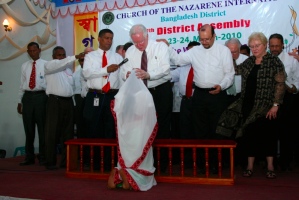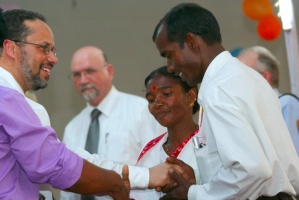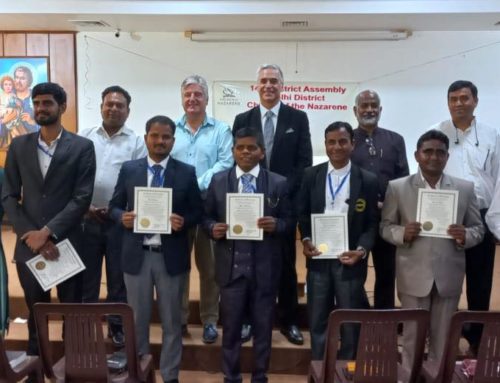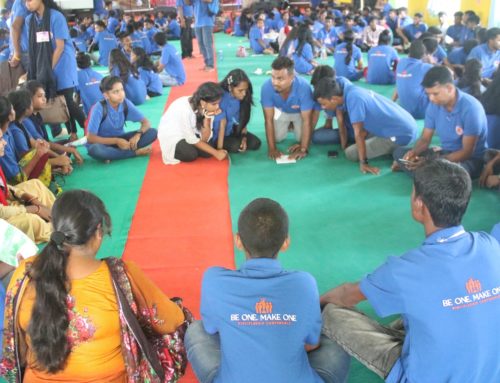 Dinajpor, Bangladesh – Dressed in spotless white, two long lines of men and women stood in the dusty yard under the hot spring sun of Bangladesh, waiting to make history.
Dinajpor, Bangladesh – Dressed in spotless white, two long lines of men and women stood in the dusty yard under the hot spring sun of Bangladesh, waiting to make history.
As the first musical notes were struck, the 193 future elders, including 30 women, marched along a red carpet and into the large hall to be ordained during the 17th Bangladesh District Assembly on March 24.
The ordination marks two milestones, not only for the district but also for the 100-year-old global Church of the Nazarene denomination: The group is both the largest ordination in history, and the largest number of women to be ordained at an assembly.
With electricity flickering on and off, and only fans to cool the packed house of more than 2,000 attendees, the ordination ceremony lasted nearly four hours. Candidates knelt at an altar, sometimes with their spouses and even infants, as one of four general superintendents laid hands on their heads and prayed the traditional charge to pastoral ministry.
The unprecedented size of the group required two sitting general superintendents and two emeriti general superintendents to complete the ordinations. On the platform, local elders joined Dr. Jesse Middendorf, who presided over the ordination, and Dr. Eugenio Duarte, along with emeriti Dr. Nina Gunter and Dr. James Diehl, to pray over each candidate.
 “Church will not be the same tomorrow,” said District Superintendent Sukamal Biswas. “The district will be on fire to involve themselves in mission. They will carry out the mission on the local level. This will be a tremendous impact on the district life and on the life of the local church.”
“Church will not be the same tomorrow,” said District Superintendent Sukamal Biswas. “The district will be on fire to involve themselves in mission. They will carry out the mission on the local level. This will be a tremendous impact on the district life and on the life of the local church.”
One might argue the Church of the Nazarene in Bangladesh is already “on fire.” There were 10 churches organized by 1996. By 2002 the district surpassed 100 organized churches. That number increased to more than 1,220 at the end of 2009. Essentially, the district grew over 10 times its size every seven years. This does not include churches that are meeting but are still working toward fulfilling the denomination’s requirements for official organization.
Having enough trained ministers to lead the explosion of growth is crucial, said Ron Gilbert, strategy coordinator of the South Asia Field, of which Bangladesh is a part.
“You must have in a movement trained and qualified leaders that will be able to reproduce themselves,” Gilbert said. “If we’re going to have a strong, developed work, we must have well-educated pastors who can educate the laity.”
All of the newly ordained pastors graduated from South Asia Nazarene Bible College (SANBC) on March 23, having completed 25 courses of up to 120 hours each, plus 5 courses on holistic, compassionate ministry and disaster relief – which exceeds denominational requirements for ordination. In addition, every student was required to either plant or pastor a church while enrolled in the 3- to 5-year program.
The ordaining of so many women holds special significance for the church in Bangladesh: the denomination is the first in the country to ordain women clergy. The step will encourage more women to involve themselves in ministry – this in a society where women are not traditionally allowed to be decision-makers, Biswas said.
Not only did the district ordain nearly 200 elders, it issued 695 district licenses. A district license is issued for one year to a lay person who wishes to answer a call to preach.
The new pastors will face great challenges as they lead their churches, said the SANBC Principal, who requested prayer that they would be given boldness, courage and God’s protection.
“Many will serve in isolated places where they may not have somebody else to encourage them. Let’s pray that they will be closer to God and God will protect and help them.”
{gallery}OrdinationBangladesh2010{/gallery}
Click on the image to view more pictures of the Ordination Service.



